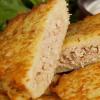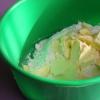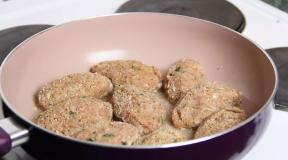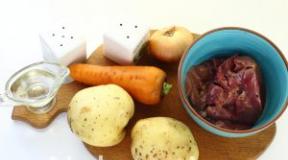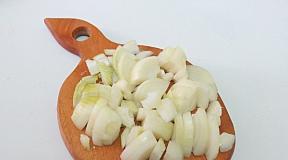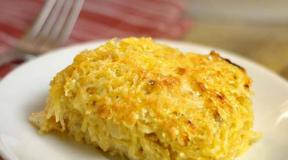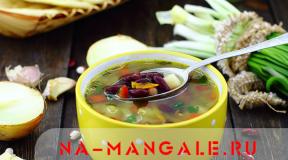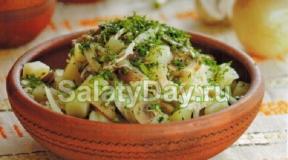Green fruit. A complete list of delicious exotic fruits and berries with descriptions
On store shelves, but usually there is a smaller part of all the exotic. Some of them have an unusual taste and color, which is why you really want to try them.
Encyclopedia of exotic fruits: Russian and foreign names
Did you know that thai name pineapple - "sappalot"? In the countries where it grows, this fruit is unusually tasty and differs significantly from its counterparts brought to Russia. It is eaten raw, canned and used in salads, main courses and desserts.
Watermelon, or dengmo, comes in red and yellow, but these differences do not indicate maturity. The first variety is very sugar and sweet, while the second has a less pronounced taste. Thais believe that they bring happiness and wealth, moreover, in it fewer seeds... It is especially beneficial for diabetics due to its lower sugar content. This variety is bred by crossing a red and wild watermelon.
Thai melon is called "deng tai". In Russia, no more than three varieties of this plant of the Pumpkin family are known, and all of them are imported from Tashkent. In Thailand, melons are more abundant, but they are all less sweet and more watery.
Mango, or ma-muang, is eaten in the countries of Southeast Asia in a green form with spices. This fruit is yellow with big bones recognized as one of the best in the world. In Russia, its taste is less pronounced and sometimes even resembles green grass. While in Thailand, be sure to bring a few fruits home - they can be stored in the refrigerator for almost a month.
Maprao is a coconut that comes in two varieties in exotic countries. The so-called "hairy" fruits are used to make shavings, while the large and green ones are eaten whole. Coconut milk is especially useful: its constituents normalize cholesterol levels. Sometimes women strengthen their hair with this liquid and improve the skin of the face.
Citrus companions
Nowadays, grapefruits can hardly be called exotic fruits, because all Europeans are familiar with their sour-bitter taste. Its pulp may sound unpleasant, but this citrus makes an excellent tonic drink that can be drunk like lemonade or combined with strong alcohol.
Pomelo has less juicy pulp, but more pleasant taste... The thick peel is easy to peel, and under it there are medium-sized slices, separated by partitions. Russians consider this fruit exotic and eat it naturally, while Asians season it with salt, pepper and other spices before eating it. Pomelo grows in the United States, Israel and the countries of Southeast Asia all year round, so the cost in Europe is low. Due to the high content of essential oils, fiber and vitamins, this yellow fruit is very useful and is widely used in cosmetology and cooking.
Scary delicious
Curly bunks, or "pomegranate apple", resembles a cucumber with pimples in its shape. The outer shell, which beckons with its unusual appearance, is not eaten, but you will be surprised to find small under it.They taste a little tart and resemble ordinary peas. This miracle can be found in Turkey.

Many have long heard the name "Buddha's Hand", but if you do not even imagine what yellow fruit might look like that, go to China or Japan to see this miracle in person. In appearance, the plant really resembles human fingers. Such a miracle costs a lot of money, however, it taste qualities do not meet expectations. The Buddha's Hand consists entirely of an inedible bitter-sour rind. The fruit smells of violets and is more like a souvenir than a food product. The maximum that can be made from it is to make jam or jelly.
Thai counterparts of well-known fruits
If you have ever wondered what kind of yellow fruit resembles an orange, we will show you. It is called a kumquat and is native to China. The rind of these citrus fruits is very thin and edible, and the size does not exceed four centimeters. The kumquat tastes like an orange, only more sour and bitter. Save a few seeds and try planting them in a pot, and you may soon have a small tree. In China, it ripens in the last months of spring and early summer, and you can find it on the market all year round.
The yellow nispero fruit is similar to an apple, and some call it "Japanese plum" by analogy. The plant is grown in Spain and is rarely exported abroad - the fruits are very perishable. While in this sunny country, be sure to make jam, marmalade or jam from nispero - its sweet and sour taste will pleasantly surprise you.
The Mariana plum resembles the gifts of the plum tree in size and shape. The fruit has a sweet and sour taste, reminiscent of apple jam... The tree is also called plum-mango. In Thailand, this delicacy is sold at a price equal to 100 rubles per kilogram - now imagine how much Russian suppliers would ask for. The mariana plum is harvested only in spring.

Mafai is a yellow fruit with a seed inside, which in its appearance resembles light grapes, however, its pulp structure is different. The inner cloves are like garlic cloves, and they taste sweet and sour. The stone is bitter and does not detach from the pulp. The mafai's rind is very thin and smooth, but inedible.
Giant yellow fruit: what is it called and eaten

Exotic plants amaze not only with their unusual taste, color and shape, but also weight. In countries with a tropical climate, due to high humidity, real giants grow. The record holder among woody fruits is considered kanuun, or - a yellow fruit with miniature spines. Its weight reaches 34 kilograms - it is amazing that the thin branches can withstand this giant. In terms of taste, it rather resembles not bread, but a melon or marshmallow. The whole kanuun is sold, and skilled Thais skillfully cut it right in front of customers, weighing the juicy pulp. Some people may have an allergic reaction with a spasm in the throat, but this will go away after a couple of hours. By the way, Thais sometimes call this plant a jack fruit.
Spiky but tasty
Durian - unusual fruit yellow with dark pimples, the second largest after kanuun. Many oppose its great taste and unbearable smell, and only the most daring dare to try it. Insist that the vendors cut up the durian in front of your eyes - the flesh that has lain down a little is less sweet. Despite its pleasant taste, the smell of this fruit is simply unbearable, which is why it is forbidden to enter hotels and planes with it. It is not recommended to drink durian with alcohol, otherwise there will be a possibility of an increase in blood pressure.

Kiwano's skin is covered with small horns. It tastes like cucumber, melon and banana. Kiwano is eaten in fresh and because of amazing taste it can be combined with salt. Biologists are still arguing about whether this fruit should be attributed to fruits or vegetables. Kiwano grows on vines mainly on the African continent, America and New Zealand. The bones are soft, so they can be safely eaten with the pulp. The fruit tastes good both ripe and unripe. Unripe fruits are paler, orange is indicative of medium ripeness and red is fully ripe. Some exotic yellow fruits are poisonous, so before eating, ask the seller how edible their peel and bones are.
And Thai bananas are different!
In European countries, one variety of banana is known, which has an elongated shape and can be green or yellow in color. This delicacy is imported to Russia from Southeast Asia or Spain at a price of just over eight rubles per kilogram, including all taxes. In Moscow, the cost in various retail outlets may be different. You will give the least for a kilogram of bananas in the Auchan hypermarket - 21 rubles; in "Pyaterochka" and "Kopeyka" - from 30 to 40 rubles; and in the network "My store" this exotic fruit can cost more than 60 rubles.

Thai delicacies are full of their diversity, and upon arrival in exotic countries, Russians forget about rest and begin to feast on juicy fruits. Several types of bananas are grown in Southeast Asia. The "nam va" variety looks three times smaller than its usual size. It is surprising that the name of the fruit is given in Arabic by analogy with human limbs. According to many scientists, this yellow fruit was the first that ancient people began to cultivate. The first mentions of it can be found back in 600 BC. Baby bananas are shaped like an elongated egg. They are very sweet, have a honey taste and are much more expensive in Russia. It takes several hours to transport bananas from exotic countries to Russia, so in most cases they are picked green - they ripen on the way. If you can find ripe and unripe bananas and you don't know which fruit to buy - yellow or green, experiment and choose the second option. Place your purchase in the closet for a few days. You will be surprised when you get a fully ripe banana.
Everyone has long been accustomed to the fact that fruits and vegetables should have the usual aroma - juicy sour, sweet or bitter pulp, which has nothing to do with other products. There are several exclusive plants, by trying which, you will change your idea of the gifts of fruit-bearing trees. Anona tastes like condensed milk - it is a real paradise for diabetics and those with a sweet tooth. Under the outwardly unattractive skin, similar to the scales of a reptile, there is a white pulp with small black seeds. If in the crossword puzzle you come across the task "which yellow fruit (5 letters) tastes like condensed milk", you will know that this is anona.
The cocoon looks like an apple and a persimmon. The fruits of this tree are considered fruit, while they taste like a mixture of tomato and lemon. The core of the cocoon is the same as that of a tomato, only yellow in color: small bones are surrounded by a jelly-like pulp.
Longan is a yellow fruit with a black stone inside, for which the plant is called "dragon's eye". In taste and shape, the fruit is similar to lychee and mafai, the pulp is very sweet and aromatic. The bowels of Longan contain vitamin C, iron, calcium and many acids useful for the human body.
What yellow fruit resembles a star?
The best restaurants often offer desserts decorated with exotic vegetation. Their cost is much higher than an ordinary serving of ice cream or cheesecake, but visitors to the establishment get real pleasure from eating beautifully decorated dishes. Carambola, or " star fruit", its external shape resembles a cucumber with several faces, and in section it becomes like a five-pointed star.

Carambola can taste bland, sour, or slightly sweet, so it is not eaten raw. If you were offered a dessert or a main dish, decorated with this fruit, do not deny yourself and try it anyway, because the pulp is a source of vitamin C. contained in carambola, is contraindicated for people with malfunctions in the kidneys and urinary system. In the store, this fruit can be bought at a price of 500 rubles per kilogram. Carambola grows in Brazil, Ghana, India, Thailand, Southeast Asia, the states of Florida and Hawaii and Sri Lanka. It is curious that this yellow fruit can be in the shade, unlike other tropical plants.
Physalis is often used to decorate desserts - a berry in a so-called "box", which resembles a cranberry in its external shape, only has a golden color. Contains B vitamins and others useful material that improve human health. Physalis helps in the fight against endocrine and circulatory system... It improves digestion and strengthens the immune system, due to which it becomes useful people who underwent surgery. Some varieties of this plant are inedible, so it is used most often for decorative purposes. In cooking, they are often used for decoration. bright fruit yellow color. Photo ready meals with their use, they are able to enchant even the most demanding gourmet.
Quince jam - sweet, tasty, yellow!
In the Asian countries of the former Soviet Union there are not many fruits, vegetables and berries that can surprise a Russian. It is much more interesting for European residents to feast on fruits of a bizarre shape, such as carambola, kiwano or eve. Exotic yellow fruits are more often consumed raw, but due to their high cost they are rarely used in cooking, which cannot be said about quince. It tastes like a dry apple with an astringent effect, but it makes an excellent jam.
For cooking, you need a kilogram of quince and sugar, a glass of water, citric acid and vanillin to taste. The fruit must be washed, cut into several pieces and the seeds removed. The pieces are placed in a saucepan and filled with water, after which they can be boiled. When the fruits become soft, take them out and continue to boil the water, adding sugar to it. After that, quince slices can be put back in the broth and boiled. The next day, continue making the jam until the fruit turns red - only then can you add vanilla sugar and citric acid. Ready jam poured into sterilized jars and rolled up for the winter.
A small tour of the fruits of Thailand, their description, prices and seasonality. There are a lot of fruits, and they all deserve special attention, because they are incredibly tasty and unusual.
(Durian)
Thai name: too rian / too-ree-an (turian)

This is the most popular fruit in Thailand! It is about him that there is as much talk as they do not talk about any other fruit. Durian is often argued about, because he has both many passionate lovers and haters.
The season for this divine fruit of Thailand starts from April-May to September, with a peak in August. When it ripens, its awesome aroma begins to be very noticeable through the peel, which can begin to burst on its own, although it is very thick and tough. When ripe, the pulp is very creamy, reminiscent of ice cream or cake cream, sometimes condensed milk. When people first taste durian, many people think that its sweetness has a hint fried onions, and sometimes flavors of dumplings / whites. But after the second or third try of durian, no one feels anything like it. There are many varieties of durian, and they all differ greatly in both taste and appearance.
The durian pulp is slightly greasy, about 5 grams per 100 grams of product. This is a very satisfying fruit! Usually, durian lovers eat so much of it that they quickly gain weight.
Your best bet is to buy unrefined durian and either clean it yourself or have a salesperson do it in front of you. The thing is that already opened, purified durian is rapidly oxidized in air, which is why it may not acquire nice smell and taste. Fresh same good durian will never cause discomfort.
Inside pieces of pulp, which is yellow, orange and white, there is one large brown bone. Durian is usually eaten with hands, without any appliances.
(Jackfruit)
Thai name: ka-noon / kha-nun (kanun)

This is the largest fruit in the world! Its weight can reach 40-50 kg. In Thailand, it is most often sold already peeled, precisely because of its large size, and also because of the problems with butchering it. The fact is that the layers between the segments of the jackfruit pulp contain a sticky substance - latex ... which can only be washed off with oil (coconut, vegetable or other).
On average, jackfruit fruits weigh 10-15 kg, and one fruit contains from 100 to 500 segments of pulp (lobules), each of which has a large bone inside. Thais do not throw away jackfruit pits, but fry and eat them. In taste and consistency, they resemble fried potatoes... And raw jackfruit seeds, respectively, raw potatoes.
(Carambola, Star Fruits)
Thai name: ma-fuang (mafuan)
Very juicy watery fruit, but the taste is not very bright (slightly sour). This fruit is more beautiful than delicious. Maybe someone will like it, but I did not get it.
Season: all year round.
(Wax Jambu, Java Apple, Rose Apple, Water Apple, Bell Fruit, Malay apple)
In Thai: Chom-phoo.
Something like carambola, a beautiful fruit and very juicy, but the taste is not bright ... coniferous. There was even a feeling that I was chewing the needles from the tree. The shape is unusual, with a bell.
Season: winter and spring (but on sale all year round)
Pineapple
Thai name: saparot

Thai pineapples are incredibly sweet. There are three varieties:
1) Elongated thorny yellow pineapples with bright yellow flesh of a dense consistency, like that of cabbage.
2) Plump pineapples with green or yellow-green peel and light yellow almost white flesh of a very delicate consistency, super juicy.
3) Tiny sugar mini pineapples.
Season all year round.
Read about all varieties of pineapple in Thailand.
Watermelon
Thai name: taeng mo (teng mo)
Thai watermelons are incredibly sweet by tropical standards. Much sweeter than Indonesia, Malaysia and the Philippines. Their sweetness is similar to that of Vietnamese watermelons. The most common variety is small, dark-skinned watermelons. Their average weight is from 2 to 4 kg.
There are also yellow watermelons in Thailand. Outwardly, they differ in the color of the peel - it is light green with characteristic stripes. Yellow watermelons in Thailand are significantly more expensive than red ones. By the way, they taste different from red ones, no matter what they say. Red watermelons have their own signature watermelon flavor, which is not found in yellow ones. Yellow watermelons are simply sweet.
Bananas
Thai name: kluey / kluai
In Thailand, there are also large bananas, like Ecuadorian ones, which are sold in Russia, but small bananas are most appreciated here. The most common Thai bananas are as follows:
1) Small plump ones with plush skin (they are also Thai hairy bananas). The variety is called. They have a white, sugary flesh, often with large black seeds almost the size of a pea. It is necessary to choose such bunches of bananas of this variety so that there is not a single gram of green on the peel, it is even better that the peel begins to turn black. Then the bananas will be really tasty and sweet.
2) Small thin elongated bananas. Very aromatic, with sweet white flesh.
3) Small short bananas. They have a bright yellow flesh, strong sweetness and rich aroma.
Season all year round, grow like weeds in Thailand.
Pomelo(Pummelo, Shaddock)
In Thai: som-oh.

It is very different from those pomeloes that are brought to Russia. Have thai pomelo the taste is very pleasant, not intrusive, at the same time bright. The varieties with pink flesh are especially tasty.
Thai name: som (catfish)
These are Thai tangerines. Their peculiarity is that the skin is often completely green or green with orange, while the pulp is always bright orange, with a bright taste, not like classic tangerines. Season all year round.
By the way, tropical citrus fruits always have a green rind due to climatic conditions. Only in cooler climates does the rind turn orange.
It is a relative of the mango. Small sweet and sour fruits. For Thai plums to be really tasty, you need to choose super ripe fruits. Otherwise, this fruit will be tart, sour and completely tasteless.
The season is from December to March.
Thai name: som-tra (somtrA)

These are imported oranges from the USA. It doesn't grow its own oranges in Thailand.
Their prices are different, from 39 to 140 baht / kg.
Melons
The taste of Thai melons is not at all bright, they are more like sweet pumpkins. Juicy, refreshing, but not comparable to the Uzbek Torpedoes. Small, 1.5-2 kg. Beige ones cost 35 baht / kg, yellow ones cost 79 baht / kg and green ones 99 baht / kg. Their consistency is not quite melon - more watery.


(Lychee, Lichee)
Thai name: lin-chi (lynchI)

Santol(Thai apple, Santol, Kechapi)
Round fruit, about the size of an apple, beige in color. Inside are white lobules containing small bones. Externally and in taste, the pulp resembles mangosteen, but still less tasty. Santola seeds are not separated from the pulp at all, which is why very few people like this fruit.
Season: May-August.

Grenades(Pomegranate)
Thai name: phila
Thai pomegranates have a light skin. Not as tasty as Uzbek and Turkish.
Season: August-October.

In Thailand, they are grown very, very little, which is very strange, because in all countries bordering Thailand, everything is in perfect order with avocado. It is Thai avocados that can be found on sale in September and October, but in limited quantities. Price 79 baht / kg. Have been seen in Makro supermarket and on.
Outwardly, you might think that this is an imported variety, but in fact it is Thai avocados grown in Thailand. And they are smaller than the Khasses, the consistency is coarser, less fatty, and they have a pine-nut taste. 
Tatiana Solomatina
TOP 10 exotic fruits: where are they and what tastes like?
Hello, friends! Going to a southern country on vacation? Then you just need to find out what exotic fruits are. Today it will be about tasty and healthy.
Read a brief overview: the appearance and taste of the fruit, the ripening season, storage features. See photos and videos.
This round tropical fruit is red in color and can grow up to 5 cm in diameter. There is one bone in the middle of the berry. In its shape, texture and bone, the fruit is similar to lime-yay, but only with a more pronounced aroma and taste. The fruit is very tasty, sweet and juicy, although sometimes slightly sour. Under the peel, which can be easily removed, there is a white plum pulp.
Fresh lychees can only be found during the harvest season, which begins at the end of May and lasts until the end of July. Between the ripening seasons of the fruit, you can find it canned in jars or plastic containers. Lychees are usually canned in own juice or in coconut milk.
Ripe exotic fruits can be stored in the refrigerator for about two weeks. If you peel them and freeze them immediately, then they will lie in the freezer for up to 3 months and retain all their useful properties.
Where to try: Thailand, Cambodia, Indonesia, Australia, China.
It is worth noting that lychee fruits contain pectin substances, proteins, potassium, magnesium and vitamin C. Those who consume enough of these exotic fruits, due to their very high content of nicotinic acid (vitamin PP), usually do not suffer from atherosclerosis. Therefore, in the region where lychee grows, the level of this disease is quite low.
Rambutan - "hairy fruit"
The fruits of this exotic fruit are round, red in color, about 5 cm in diameter, covered with a skin with soft spines resembling spines. Under the skin is white-transparent flesh, sweet in taste and sometimes with sourness. The bone is difficult enough to separate from the pulp, but it is also edible.
The tropical fruits of rambutan contain vitamin C, as well as a lot of carbohydrates, protein, phosphorus, calcium, iron and niacin, which are very beneficial for health. The shelf life of such fruits is short - up to 7 days in the refrigerator.
The ripening and harvesting period for these fruits is quite long, from May to October.
Where to try: Malaysia, Thailand, Indonesia, Philippines, India, Colombia, Ecuador, Cuba.
Jam is made from the fruit of rambutan, jelly is made, and the pulp is also canned.
Mangosteen can also be called garcinia or mancut
These exotic fruits are dark purple in size as small apple... The rind of the fruit is very thick and inedible, while the edible white flesh looks like garlic cloves. Delicious, sweet pulp with a slight sourness has a peculiar taste unlike anything else. There are no seeds inside, although some fruits sometimes contain small soft seeds, but they can be eaten.
Sometimes there are defective mangosteen fruits, they have a dark creamy, sticky and unpleasant flesh. But in appearance, such fruits cannot be distinguished from normal ones until the peel is removed.
Harvested from April to September.
Where to try: Myanmar, Thailand, Vietnam, Cambodia, Malaysia, India, Philippines, Sri Lanka, Colombia, Panama, Costa Rica.
Tropical fruits of mangosteen contain beneficial natural biologically active substances which help relieve inflammatory reactions such as redness, swelling, heat, painful weakness.

Dragon eye - pitahaya, pitahaya
These tropical fruits cactus so called in the Russian version, in the world this product is better known under the name Dragon Fruit.
The fruits themselves are oblong and large, about the size of the palm, the color of the fruit is red or pink. The pulp inside the pitaya, dotted with small black seeds, is white, sometimes with a reddish tint. The taste is very juicy, tender, slightly sweet, with a taste unlike anything else. The pulp can be eaten with a spoon, scooping up from the fruit cut in half.
Pitaya fruits are harvested all year round.
Where to try: Vietnam, Thailand, Philippines, Indonesia, Sri Lanka, Malaysia, China, Taiwan, Japan, USA, Australia, Israel.
These exotic cactus fruits are considered useful in the treatment of endocrine diseases, diabetes mellitus, and stomach pains.
Durian is the king of fruits
The exotic fruits of durian are very large, up to 8 kg. The skin of a round fruit of a dark green color resembles conical spines, such as a large hedgehog.
This tropical fruit is famous for its scent. Many have heard of it, some are familiar with its smell, and very few have tasted it. The smell is reminiscent of the smell of garlic, onions and old socks. Because of this smell, it is forbidden to bring the fruit into public places: hotel, transport, beauty salon. For example, in Thailand, signs with the image of a crossed out fruit are hung in front of the entrance.
Although the fruit pulp itself is sweet and tender, which is not combined with an unpleasant smell. But not many people dare to try this fruit. And in vain, because the taste is very pleasant, and the fruits of durian are considered in Asia valuable product with useful properties. Durian is a powerful aphrodisiac.
The harvest period starts in April and ends in August.
Where to try: Thailand, Vietnam, Malaysia, Cambodia, Philippines.
It is worth noting that durian cannot be combined with drinking alcohol, because blood pressure can rise sharply and this will lead to unpleasant consequences.
Sala, other names: herring, snake fruit, rakum
Fruits are small, oblong or round shape are red (rakum) or brown (herring) color, covered with small spines on top.
This fruit has an unusual, bright sweet and sour taste... Some say it resembles a pear, others a persimmon. It is worth trying it yourself - at least once.
When peeling an exotic fruit and peeling off the skin, you need to be very careful, as the thorns are quite dense and can dig into the skin. Better to use a knife.
Fat ripens from April to June.
Where to try: Thailand, Indonesia, Malaysia.
Carambola - "the star of the tropics"
If you cut a tropical fruit in half, you get a star in the cut. The color is yellow with a tint of green, the size of the fruit is small, there are small seeds inside.
A distinctive feature of an exotic fruit - edible peel(can be eaten whole) and, of course, an unusual shape. It has a pleasant smell, and the taste is not distinguished by anything - a little sweet or even sweet and sour. The fruit itself is juicy - you can quench your thirst.
Ripens all year round.
Where to try it: Borneo, Thailand, Indonesia.
The fruit of carambola is not advisable for those who have pronounced malfunctioning of the kidneys.
Longan or lam-yay
Exotic longan fruits are small, resemble small potatoes, they are covered with a thin inedible skin, and inside there is one inedible bone.
The taste of longan pulp is rather peculiar, juicy and sweet, even aromatic.
Longan fruits are harvested from July to September.
Where to try: Thailand, Vietnam, Cambodia, China.
These tropical fruits are very useful because they are rich in vitamin C, iron, calcium, phosphorus, and contain a lot of bioacids. So that the fruit does not deteriorate quickly, you should choose a ripe fruit, with dense skin, no cracks.
Longkong - another name for longcon
Longkong fruits are also similar to longan and small potatoes, only larger in size and pale yellow in color. Inside, the pulp resembles garlic in appearance.
The exotic longkong tastes sweet and sour. Its fruits contain phosphorus, calcium, carbohydrates and vitamin C. pleasant aroma the smell will also be useful, as it serves as a good repellent.
This tropical fruit does not last for a long time (in the refrigerator - 4-5 days), while the peel ripe fruit should be tight and free of cracks.
Fruit picking takes place from April to June.
Where to try: Thailand, Vietnam, Philippines, Indonesia.
You can find a type of longkong - langsat, they do not differ in appearance, but the second has a bitter taste.

Jackfruit or Eve - the fruit of the Indian breadfruit
The jackfruit fruit is perhaps the largest exotic fruit among those that grow on trees. Its weight can reach 35 kg. The edible flesh inside the fruit looks like a few large yellow lobules.
The taste of jackfruit pulp is sugary-sweet, reminiscent of melon and marshmallow. The fruits of this fruit are very nutritious, they contain a lot of starch, they contain about 40% carbohydrates - this is more than in bread.
Tropical fruits ripen for a long time: from January to August.
Where to try: Philippines, Thailand, Vietnam, Malaysia, Cambodia, Singapore.
It is inconvenient to store such a large fruit entirely (it can be stored in the refrigerator for up to 2 months), it is better to buy slices of pulp, already cut and packed in polyethylene. It is worth knowing that after eating jackfruit, some people have an allergic reaction: cramps in the throat, it becomes difficult to swallow. This usually goes away after a while, but you need to be careful.
Appetizing, isn't it? All these tropical fruits are exotic only for us, they are familiar to the inhabitants of southern countries. For dessert, I suggest you look interesting video, which details many of the fruits in my selection.
You will have noticed that many of the above tropical fruits grow in Thailand. I managed to try almost everything. I just couldn't appreciate the taste of the stinky durian. It turned out to be beyond my strength. Have you tried it? Write in the comments, it is interesting to know your feelings. Better yet, send stories, reviews and reviews about your vacation. I will definitely publish them in the section “Readers' travels”, read the details.
Subscribe to blog updates, there are many more to come useful information... Now I say goodbye for a while, see you again!
Tatiana Solomatina
An article-review of exotic tropical fruits of Asia with photos, names, descriptions and prices in Vietnam, Thailand, Malaysia and Indonesia. We wrote it based on our travel notes. Use it to your health!
The tropical fruits of the Southeast are a real treasure and a storehouse of health. It's just a sin not to try them all! In addition, exotic fruits sold in Russia (for example, pineapple, mango, bananas or carambola) only vaguely resemble real ripe fruits. Read the article about - it is especially relevant for those who are going to this country for the first time.
Last Minute Tours search on the services and - they will find the best deals among different tour operators. Want to save money? Explore our.
We give a discount of 1500 rubles! Enter coupon UAFT1500make-trip when buying a tour to Thailand in the amount of 80,000 rubles for and get a discount.
List of tropical fruits with photos, names and descriptions
Rambutan (Ngo - Thai, Chôm chôm - Vietnamese)
The funny hairy red balls on the counter are rambutans. Their "hairiness" is of varying degrees: the hairs can be greenish and strong, withered and black or moderately dry. Practice shows that the latter are the best.
The flesh of rambutans is dense and white, translucent, it does not get off the stone too well. To get to the pulp, you need to make an incision across and part the halves. The taste is subtle and sweet, similar to Green grapes... Unripe rambutans can be slightly acidic. Sometimes there are already peeled rambutans in the markets, but they deteriorate much faster - there is a risk of running into spoiled ones. They are also sold canned with sugar syrup.
Season: May to October.
Rambutans are one of the most inexpensive tropical fruits in Asia. Prices per kg:
- in Vietnam - from 40 thousand dongs;
- in Thailand - from 30 to 150 baht (and about 15 baht for a peeled backing);
- In Indonesia (Sumatra) - 10 thousand rupees.
(Photo © jeevs / flickr.com / License CC BY-NC-ND 2.0)
Lychee (Litchi, lin-chi - Thai, vải - Vietnamese)
Lychee, otherwise - litchi, or Chinese plum - remarkable and tasty. The neat reddish-pink fruits from afar resemble the skin of a reptile - their rind is dotted with small tubercles. They are pleasant to the touch, elastic, rough. The thin shell is easily separated from the pulp, revealing a translucent white mass with a pit in the center. Lychee is very juicy, with a sweet and sour taste. They are actively used in cooking.
The crop is harvested from April to June. The price per kilogram in Thailand is about 60 baht.

(Photo © su-lin / flickr.com / License CC BY-NC-ND 2.0)
Longan (Lam-yaj - Thai, Nhan - Vietnamese)
If you see bunches-panicles of small potatoes on the counter - you should know that this is a longan, or dragon eye... The fruits are juicy and sugary-sweet - it is almost impossible to tear yourself away from them: the longan clicks like seeds, easily and quickly. Longan shells can often be seen on the ground in Vietnam. The pulp is transparent white, sometimes with a slight yellowish tinge. When cut, the longan resembles a dragon's eye, since there is a round bone inside, hence its name.
Season: May - November.
Prices per kilogram:
- in Vietnam - from 30 thousand dongs;
- in Thailand - from 60 baht.

(Photo © Muy Yum / flickr.com / License CC BY-NC-ND 2.0)
Longkong (Langsat)
Longkong (langsat) is one of the most delicious exotic fruits in Asia, in our opinion. It looks like a bunch of small beige-yellow potatoes with specks, but larger than a longan. The long kong is cleaned well - you just need to peel off the peel (although your hands will be a little sticky after that). The pulp is in the form of translucent lobules, similar in shape to garlic. His taste is simply amazing - sweet and refreshing, with a barely noticeable sourness, a bit like a pomelo. Beware of biting through the bones - they are bitter.
Season: May to November.
Prices per kg:
- in Thailand - from 100 baht;
- in Indonesia - from 10 thousand rupees.

(Photo © Yeoh Thean Kheng / flickr.com / CC BY-NC 2.0 License)
Mango (Mango, Ma-Muang - Thai, Xoài - Vietnamese)
The variety of mango species is striking - from dark green to red. The palate is also impressive. In Vietnam, mangoes are somewhat fibrous, while in Thailand their flesh is more uniform and aromatic. The bone is usually flat and wide.
It is better to choose slightly soft mangoes, hard ones may turn out to be unripe (although there are exceptions), and too soft - overripe, such will quickly deteriorate. In thailand yellow mango(and durian) eaten with gluten-free rice and coconut milk is a traditional sticky rice dish.
Season: in Thailand in spring, in Vietnam - also in spring and winter.
Prices are different and depend on the variety (per kg):
- in Vietnam - from 25 to 68 thousand dongs;
- in Thailand - from 20 to 150 baht;
- in Indonesia - from 20 thousand rupees;
- in Malaysia - from 4 ringgit.

(Photo © Philip Roeland / flickr.com / CC BY-NC-ND 2.0 License)
Noina, or sugar apple (Sugar Apple, Noi-na - Thai, Mẵng cầu - Vietnamese)
Noina is very similar to cherimoya - they are relatives. Noina looks like a light green bumpy apple with scaly segments covered with a light whitish bloom. Sugar apple was named for a reason: the ripe fruit really looks like sugar, with a creamy taste. The pulp is white and so soft that the noinu is cut in half and eaten with a spoon, removing inedible bones... Cherimoya is a lot like Noina, but its skin is scaleless.
Try to choose as ripe fruits as possible, as unripe noina will be unpleasant - hard and with a coniferous flavor. A ripe sugar apple is soft, and the flesh can even show through between segments. Do not press too hard - it may fall apart in your hands.
Harvest: June - September. The cost of a kilogram of these tropical fruits in Vietnam is from 49 thousand dongs (in a supermarket), we bought at the market for 30 thousand.

(Photo © Hanoian / flickr.com / License CC BY-NC-ND 2.0)
Guanabana, or sour cream apple (Soursop, Guanabana, Mãng cầu xiêm - Vietnamese)
Another relative of Noina is guanabana. Its pulp is similar to sugar apple but not so sweet and with a bright creamy taste... In consistency, it a little resembles dense sour cream or yogurt, for which guanabana was nicknamed the sour cream apple. Eat it with a spoon or cut it into pieces. Guanabana fruits are much larger than noina and cherimoya, you will not confuse them - they sometimes reach 10 or more kilograms. The peel is dark green, with small processes in the form of soft spines.
Guanabana is a rare visitor to the counters of markets and shops. Choose a slightly soft sour cream apple - it can easily ripen in the refrigerator for a couple of days (but not more, so do not overdo it). An unripe fruit is hard and almost tasteless, while an overripe fruit will sour, and fermentation will begin.
It bears fruit all year round. Usually the price per kilogram in Vietnam is from 43 thousand dongs.

(Photo © tara marie / flickr.com / CC BY 2.0 license)
Pomelo (Pomelo, Som-o - Thai)
Probably everyone knows what a pomelo looks like and how it tastes, so we will not describe it. However, it seemed to us that it was sweeter in Asia. When buying, you should choose by sniffing: the stronger citrus scent, the better the pomelo will be. Also pay attention to the softness.
Season: July - September.
Price per kg:
- in Thailand - from 30 baht;
- in Vietnam - from 40 thousand dongs.
Baltic herring (Snake fruit, Sala and Ra-kum - Thai, Salak - Indonesian.)
A notable tropical fruit with a snake skin-like skin. It happens with and without thorns. The pulp is beige-yellow or white, sweet-sour in taste, with a wine flavor. Sometimes there is a valerian flavor. Herring with thorns must be peeled with care: cut at the edge with a knife and peel off like a tangerine. It is easy to clean.
Season: June to August.
Prices per kg:
- in Thailand - from 60 baht;
- in Indonesia - from 25 thousand rupees.

(Photo © hl_1001a3 / flickr.com / License CC BY-NC 2.0)
Pineapple (Pineapple, Sa-pa-rot - Thai, Khóm (Dứa) - Vietnamese)
Pineapple is an exotic fruit familiar to us from childhood. Only in Asia it is much tastier than in Russia. Large and small pineapples are sold - these are different varieties. We recommend taking Thai small ones, with a palm, with an orange crust - they are the sweetest. It is convenient to buy pineapples that have already been peeled or cut.
Season: January, April - June.
Prices per kg:
- in Vietnam - from 20 thousand dongs;
- in Thailand - about 15-20 baht (per piece or kilogram - depending on the variety).
Chrysophyllum (star apple, Caimito, Star apple, Vú sữa - Vietnamese)
We were not particularly impressed by the star apple: its taste seemed pleasant, but not outstanding, in addition, the fruits emit milky juice, which is then hardly washed from the hands and lips. Mature chrysophyllums are green, brown as well as different shades of purple. You need to choose soft star apples, since unripe are inedible. It is better to eat them with a spoon, cut across and pre-chill.
Harvested from February to March. Price in Vietnam per kg - from 37 thousand dongs.

(Photo © tkxuong / flickr.com / CC BY 2.0 License)
Mangosteen (Mong-khut - Thai, Mang cút - Vietnamese)
Mangosteen (mangosteen), like almost all tropical fruits of Asia, looks attractive and arouses the curiosity of tourists. Small dark purple round balls with neat leaves on top, dense to the touch and rather heavy.
The mangosteen peel is thick, reminiscent of pomegranate in smell and astringent properties. Behind the thick rind are several cloves of fragrant and extremely delicate white pulp, similar in shape to garlic. The taste is unforgettable and indescribable! Light, sweet, refreshing. We didn't like the mangosteen wine.
It is important to choose the right fruits: when buying, lightly press on the mangosteen - it should be a little soft, bend out when pressed. If not, it is most likely spoiled.
When cleaning the mangosteen, be careful not to stain your clothes. In many hotels it is forbidden to eat it. Clean better hands- just tear off the leaves and press on the center. You can also use a knife - make an incision and reveal the fruit. If the mangosteen is fresh, it will peel off easily.
Season: April - October.
Price per kg:
- in Thailand - from 80 baht;
- in Indonesia - from 15 thousand rupees.

(Photo © olivcris / flickr.com / CC BY-NC 2.0 License)
Papaya (Papaya, Ma-la-koo - Thai, Đu đủ - Vietnamese)
Papaya is sweet and nutritious and tastes like carrots and pumpkin. The pulp of a ripe fruit is very soft, fragrant, juicy, orange-red in color, and the rind is from bright yellow to orange. Use moderately soft fruits. Green papaya is not sweet - it is added to salads and eaten with pepper and salt.
Season: all year round.
Prices per kg:
- in Vietnam - from 10 thousand dongs;
- in Thailand - from 40 baht;
- in Malaysia - from 4 ringgit;
- in Indonesia - from 4 thousand rupees.

(Photo © Crysstala / flickr.com / License CC BY-NC-ND 2.0)
Sapodilla (sapodilla, La-mut and Chiku - Thai, Lòng mứt or hồng xiêm - Vietnamese)
Sapodilla is named woody potato - outwardly, it really looks like an oblong potato. But inside - sugary-sweet pulp of orange-brown color, reminiscent of persimmon variety "Korolek", only softer. Buy soft, brown fruits as immature sapodilla has an astringent effect.
Season: all year round.
Prices per kg:
- in Vietnam - from 21 thousand dongs;
- in Thailand - from 40 baht.

(Photo © GlobalHort Image Library / Imagetheque / flickr.com / CC BY-NC 2.0 License)
Pitahaya (dragon heart, pitaya, Dragon fruit, Geow-mangon - Thai, Thanh long - Vietnamese)
Pitahaya is one of the most recognizable exotic fruits, a photo of which, probably, everyone has seen. The bright pink pitaya belongs to the cactus family and looks unusual: inside there is white or beet-colored flesh with small black seeds. She has a barely perceptible sweetish taste- in my opinion, pitahaya is almost bland. Eat with a spoon, cut in half.
Season: May - October.
Price per kg:
- in Vietnam - from 20-23 thousand dong;
- in Thailand - from 45 baht.

(Photo © John Loo / flickr.com / CC BY 2.0 License)
Coconut (Coconut, Ma-phrao - Thai, Dừa - Vietnamese)
In Southeast Asia, coconuts are large and light green, not brown and hairy like we have on the shelves. These are young coconuts, and they are drunk. The sellers will carefully cut off the top of the nut with a machete, give you a straw and a spoon - you can scrape off the pleasant jelly-like pulp remaining on the walls of the coconut. We recommend buying chilled coconuts.
Season: all year round.
Unit price (depends on size):
- in Vietnam - from 8-15 thousand dongs;
- in Thailand - 15-20 baht;
- in Malaysia - from 4-5 ringgit.

(Photo © -Gep- / flickr.com / License CC BY-ND 2.0)
Tamarind (Sweet Tamarind, Ma-kham-wan - Thai, Me thái ngọt - Vietnamese)
The lusciously sweet tamarind is reminiscent of dates in taste and consistency. It looks like a brown pod, under a fragile shell - dark pulp, enveloping hard bones.
Season: December to March.
Prices per kg:
- in Vietnam - from 62 thousand dongs;
- in Thailand - from 100 baht.

(Photo © Mal.Smith / flickr.com / License CC BY-NC-ND 2.0)
Banana (Banana, Kluai - Thai, Chuối - Vietnamese)
There are many types of bananas in Asia. Mostly small, palm-length. The taste is sweet and very different from those sold in Russia. Be sure to try the different varieties. For example, Malaysia has wonderful triangular bananas. They are red on the outside, and they taste like dried ones.
Season: all year round.
Prices per kg:
- in Vietnam - from 15 thousand dongs;
- in Thailand - from 30 baht;
- in Malaysia - from 4 ringgit.
Passionfruit (Chanh dây - Vietnamese)
This tropical fruit has a different, more sonorous name - Passionfruit, which translates as the fruit of passion. Passion fruit taste for an amateur: too sharp, sweet and sour (but I like it very much). Similar to concentrated multifruit juice.
The rind is dense and comes in a variety of colors, but mostly purple, burgundy, brown and green-brown. The fruits can be smooth or shriveled - this is the kind of passion fruit that will be ripe. The pulp is jelly-like, with edible bones... Eat it with a spoon, cutting it across.
Season: September - December.
Prices per kg:
- in Vietnam - from 20 thousand dong;
- in Thailand - from 190 baht.

(Photo © geishaboy500 / flickr.com / CC BY 2.0 License)
Carambola (Carambola, Star fruit, Ma-fuang - Thai, Khẽ - Vietnamese)
The beautiful yellow-orange fruit is carambola. It tastes sweet and sour, reminiscent of strawberries. Carambola is juicy and refreshing and is pleasant to eat in hot weather. It is so named because it produces star-shaped lobules when cross-sectioned.
Season: October to December.
Prices per kg:
- in Thailand - from 120 baht (and 50 baht for a backing);
- in Malaysia - from 4 ringgit.

(Photo © berenicegg / flickr.com / CC BY 2.0 License)
Chompu (rose apple, waterapple, Chom-phu - Thai, Mân thái đỏ - Vietnamese)
Chompu are unusually juicy - they seem to be made of water. Perfectly quenches thirst. The taste is barely noticeable, sweetish, very pleasant. The scent resembles the scent of a rose, hence the name. Chompu are available in red, green and white.
Season: all year round.
Prices per kg:
- in Thailand - from 200 baht (and 20-70 baht for a backing);
- in Malaysia - from 4 ringgit.

(Photo © beautifulcataya / flickr.com / CC BY-NC-ND 2.0 License)
Jackfruit (Kha-nun - Thai, Mít - Vietnamese)
Perhaps one of the most memorable and delicious exotic fruits in Asia is jackfruit. Its fruit is round and very large, so it is sold peeled. The cut jackfruit smells sweet, the aroma resembles gum and travels far away. The lobules are bright yellow and smooth. The fruit is very nutritious.
Season: January - May.
Prices for jackfruit backing:
- in Vietnam - about 25 thousand dong;
- in Thailand - from 20 baht.

(Photo © mimolag / flickr.com / License CC BY 2.0)
Guava (Guajava, Farang - Thai, Ổi - Vietnamese)
We are not happy with the guava. It looks like a pear or a green apple, the taste is something in between. In general, the pulp is pleasant, sweetish, sometimes white and pink flowers... Choose a softer guava, it is impossible to eat unripe - it is hard, with a coniferous flavor.
Season: all year round.
Prices per kg:
- in Vietnam - from 19 thousand dong;
- in Malaysia - from 4 ringgit.

(Photo © cKol / flickr.com / License CC BY-ND 2.0)
Durian (Durian, Too-ree-an - Thai, Sầu riêng - Vietnamese)
The same king of fruits that everyone has heard of. Reviews about durian are contradictory: someone says that they will never eat it, while others are crazy about it. Our first acquaintance with durian turned out to be unsuccessful: the distinct taste of either onion or garlic was mixed with the sweetness - not the pleasure we had hoped for, having read the laudatory reviews about the heavenly taste of this exotic fruit. After consumption, the garlic taste lasts for a long time in the mouth. By the way, the smell is not entirely disgusting, and sometimes even pleasant - apparently, it depends on the variety. We tasted durian the second time we bought the traditional thai dish sticky rice with durian and coconut milk. What to say? Don't lie, the taste is really heavenly! The pulp is very tender, creamy. Remember that it cannot be consumed with alcohol.
Season: April - August.
Durian prices in Thailand: from 200 baht per kg (Phuket town) and from 900 baht per kg in Patong - the difference in price is impressive. It is most profitable to buy sticky rice with durian - from 55 baht per pack. Hearty and tasty. The most delicious durians are small ones that are sold in Malaysia.

(Photo © Mohafiz M.H. Photography (www.lensa13.com) / flickr.com / CC BY-NC-ND 2.0 License)
Introductory image source: © Andrea Schaffer / flickr.com / CC BY 2.0 license.
Many people think that tropical fruits are a rather dubious treat. But in fact, many of them look so that it is not clear whether this is a fruit at all. Of course, our favorite bananas, kiwi and pineapples have long found their place in our food market. But today the story will focus on more exotic and strange fruits.
Foreword
Thanks to close economic ties with Asian countries, a large number of exotic-tropical fruits began to be supplied to us, which have found their place of honor in medicine and cosmetics. People began to think more often about what foods they are consuming. And we can confidently say that quality food has become a new fashionable trend. It is tropical fruits that contain in their composition a huge assortment of various minerals and vitamins, which has a beneficial effect not only on health, but also on appearance.
Home of tropical pleasure
Southeast Asia is simply a heavenly place, given by nature to lovers of exoticism. Tropical fruits are quite common in Russian supermarkets. But most often they are distinguished from the originals not only by the price, but also by the taste itself. Sometimes they are loaded with chemicals, as many suppliers ship unripe fruit. Every day, the people of Southeast Asia enjoy the variety of fruits that grow in their rich land. Exotic fruits are common here.
Tropical fruits, the names and descriptions of which will be presented below, grow in India, Indonesia, Malaysia, Singapore and other Asian countries. They differ from each other not only in shape and taste, but also in names.
Well, let's talk about exotic fruits ...
What a dragon's eye fruit
The homeland of this interesting product is China. Here it is customary to call it longan, which means “dragon's eye”. Why is it called that? When cut in half, the longan looks like an eye. The dragon's eye is a fruit that grows on a tree adapted to tropical climates. Sometimes they are able to withstand a little low temperatures... This fruit is used not only in food preparation, but also in Chinese medicine... The Chinese eat it fresh, dried and canned.
The top of the fruit is covered with a brown rind, which is very thin and easy to peel. Next comes a dense white layer, and already inside, in the very center, there is a black seed. The dragon's eye is a fruit that has a juicy and aromatic pulp. If you make juice from longan, then it will perfectly quench your thirst in the sultry heat.

In restaurants, dragon eyes are served with ice cream. Longan contains vitamin C, phosphorus and calcium. Due to its high sugar level, the dragon's eye fruit gives strength during illness. But getting carried away with the use of this tropical fruit is clearly not worth it, as this entails an increase in body temperature. If you want to cook an exotic-tropical dessert, you need to boil the fruits of the dragon's eye and rice in sugar syrup.
Fruit of the Gods - Mangosteen
Mangosteen is a fruit that has 3 names: mangosteen, mangosteen and mangosteen. Interestingly, one product has been awarded as many as three titles. The pulp of this exotic fruit are consumed in a fresh state, but soft drinks and juices are prepared from the whole fruit. For someone who has never tried it, it is difficult to describe the taste, but you should take the word for those who claim that it is very tasty.
Despite the fact that mangosteen's rind is too hard, it has beneficial properties and is also used in the preparation of a soft drink. The juice of this exotic fruit can be preserved and then used to heal and cleanse the body. Since mangosteen is a healthy and valuable tropical fruit, its cost is quite high.
It is often found on the shelves of supermarkets in Russia. But you need to know that mangosteen is a fruit that cannot be frozen. Its shelf life is also short, so the freshness of this product on our market is questionable. You can store this fruit in the refrigerator for a maximum of 2 weeks, so it remains to be hoped that mangosteen is transported and stored exclusively under suitable conditions and no more than this period.

To enjoy the taste of the fruit, you need to work hard. And this business will not do without a knife. As soon as the thick rind is cut, cream-colored slices (4-8 pieces) appear, which are covered with a blue mesh. The taste is slightly sweet and sometimes tart.
Now let's move on to the beneficial properties of mangosteen. Not every tropical fruit can boast of solar energy, which our body needs so much. The amount of antioxidants here is simply off scale. With its detoxifying and detoxifying properties, mangosteen helps maintain weight. This fruit is the perfect complement to dietary diet, it enhances the effect of any diet. AND important information for older ladies: mangosteen helps maintain youth!
Why tropical fruits are good for you
Scientists believe that thanks to the special enzymes that are part of their composition, they help with weight loss. Tropical fruits have one thing in common and main benefit for our body: they are abundant in minerals and vitamins that are so necessary for our health. The content of vitamins C and D in them helps in strengthening the immune system. Doctors believe that a green tropical fruit like guava helps to strengthen the immune system during the winter.
Tropical star
Carambola is a fruit that resembles a five-, six-, and sometimes seven-pointed star in the cut. Her fruits are juicy and crunchy. They have two flavors: sweet and sweet and sour. This fruit is considered low-calorie, since 100 g contains only 31 kcal. Carambola is a fruit that is 90% water and contains oxalic acid. People who suffer from kidney problems should refrain from using this tropical sweetness... She - main source vitamin C and also contains a calorizer (organic acid). The fruits of this fruit are ideal helpers to relieve blood pressure and also help relieve colic, fever and headaches.

When eating, ensure that the fruit is intact. If you want to buy sweet fruits, choose yellow fruits because green ones have a sour taste. You can store carambola in the refrigerator, but not more than a month. If you have purchased unripe fruits, do not despair. Keep them for several days in room temperature, during this time they will ripen, and then you can transfer them to the refrigerator. Carambola can be consumed fresh or added as an ingredient to fruit salads. To prepare the salad, you need to cut carambola, papaya, strawberries, then add blueberries to them and season it with the juice of a whole lemon.
Rambutan: this is exotic
Rambutan is a fruit that has not only an unusual name, but also an interesting appearance. Many people think that this fruit is grown by selection, but this is a delusion! It grows naturally. The exoticism of rambutan lies in its appearance, which looks more like a puffer fish. Many anglers know what it is poisonous fish... This fruit is just as poisonous. Therefore, the seeds of an exotic plant must be fried before use. Rambutan is a fruit that has a sweet taste (sometimes with a hint of sourness) and a rather pleasant aroma. The calorie content of rambutan is high compared to carambola - 60 kcal per 100 grams. But if you take into account the fact that the fruit is rich in minerals, fructose and vitamins, then this is quite a bit. Today rambutan is grown in Thailand, Sri Lanka, Malaysia, Indonesia, India, Australia, the Caribbean and Central America.

Before eating rambutan, you need to get rid of the inedible peel. In order to remove it, you need to cut the fruit with a knife or press down with your finger and, after a crack appears on the surface, divide the skin in half. After that, only white pulp with a bone inside will remain in the hands. Raw seeds are poisonous, while fried they are quite edible.
Of course, most often rambutan is consumed raw, but in some countries it is canned like pineapple. It also makes very delicious jams, compotes and desserts.
Thai women use its pulp to massage their face, they are confident that this procedure rejuvenates the skin. Fruit consumption is recommended for those who want to a short time regain your strength. It also reduces the risk of developing cardiovascular disease... With regular consumption, the kidneys are visibly cleansed.
When buying rambutan, you need to focus on its color. Ripe fruit has a bright red peel, the hairs are not prickly and slightly greenish tint at the ends. If the hairs of the fruit are dry, this means that either the fruit has begun to deteriorate, or is already overripe. Even though the shelf life of rambutan is short, it is the most imported tropical fruit. But it is best consumed in the countries where it grows. It's cheaper there, and the taste is different.
Hellish smell and divine taste
An interesting fruit is durian. It tastes like cheese, cherry syrup, sweet almond cream and can cause several more incompatible associations with each other. But the fruit is famous not for its interesting taste, but for its specific smell. Tourists compare this smell to a mixture of rotten onions, turpentine and smelly cheese. Therefore, the countries growing this plant have banned the introduction of durian into public places. The fruit must be eaten very quickly, as a strong smell begins to be felt within a couple of minutes after opening the fruit. And believe me, it is not easy to withstand such a "flavor". Those who taste this fruit for the first time in their lives are impressed by the aggressive "aroma" for a long time, but amateurs compare it with spicy cheeses... Durian grows closer to the trunk, as it weighs up to 8 kilograms. Therefore, be careful: if such a fruit falls on a person, injury cannot be avoided.

It is better not to touch the pulp with your hands, as it will be difficult to get rid of the smell - it is better to use a spoon. If you close your nose and taste tropical durian, it will taste like strawberries sprinkled with nut crumbs. It is not only eaten fresh, but is often used as an ingredient in baked goods, added to ice cream or drinks, mixed with rice, or served as a side dish. Durian festivals are held in Thailand from May to August. Despite its strange smell, exotic durian will not leave anyone indifferent.
Fruit that gives pleasure
In China, lychee (or fox) is a symbol of sensuality and love. There is a legend about the emperor of the Tang Dynasty. He was so captivated by the beauty of his concubine that he ordered the servants to bring her lychee fruits as a gift, which grew 1000 km from the imperial palace. So what's the look and taste of lychee? This fruit has an oval shape with a pimpled peel of a red color. The fruit has a light jelly-like pulp that is sweet and at the same time astringent taste... The pulp can be easily separated from the rind. This plant grows very slowly and only produces a bountiful harvest in the first 2 summer months.

It is used in the manufacture of wines, drinks, juices, salads. And also lychees are canned and used in the form sweet filling for pies and other pastries. The fruit goes well with any fish, is perfect as an ingredient in the preparation of sweet and sour sauces. The fruit is low-calorie - 60 kcal per 100 grams. If you regularly use this product, then the digestive system will say "thank you". Lychee juice is used to make soft drinks as it has refreshing and toning properties. The high content of nicotinic acid in fruits blocks the development of diseases such as atherosclerosis. It is this terrible disease that causes complications in the form of stroke and heart attack. It is also advisable to use lychee for people suffering from anemia.
When buying fruit in supermarkets, pay attention to its appearance, and most importantly, to the color of the peel. If it is dark, it means that the lychee was plucked a long time ago, and its taste will resemble fermented juice. Ideally, the skin should be bright red and the fruit should be slightly soft and free of superficial damage. How to eat lychee? First you need to wash the fruit, then remove the peel (this is done quite easily), then remove the pulp on a plate and finally enjoy the taste. And if you add the fruits to a glass of wine or champagne, then exotic taste provided for you.
Unusual fruit from Asia
Jackfruit is a fruit that differs from other exotic brothers in its size. The weight of the fetus reaches 36 kg! India is considered to be the homeland of jackfruit, only then they began to grow it in some Asian countries. Not too pleasant smell contrasts with the striking taste of the fruit. Interesting taste: on the one hand, it is not too sweet, on the other hand, it is not sour. You can only eat pulp with seeds. To taste it, there is no need to wait for ripening, even unripe fruits have a delicate taste. The fruit is cut like a watermelon. If there are brown spots on it, then this means that it is either overripe or spoiled.

And in conclusion, I would like to remind you. As tasty and charming as these tropical fruits may seem, consume them in moderation, and consult with your doctor first. For the inhabitants of Asian countries, such exotic fruits are similar to our apples and pears, which we eat every day, but it is dangerous for an unprepared person to eat unfamiliar food. Therefore, before the trip, find out all your diseases and contraindications in the use of certain fruits.




